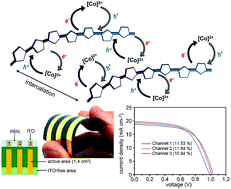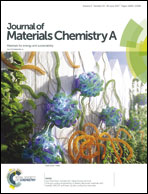Flexible and highly efficient perovskite solar cells with a large active area incorporating cobalt-doped poly(3-hexylthiophene) for enhanced open-circuit voltage†
Abstract
Poly(3-hexylthiophene) (P3HT) is a promising p-type polymer to optimize the architecture, charge transfer, and environmental stability in electronic devices. Therefore, it can be a suitable material for a hole transporting layer in lead halide perovskite solar cells (PSCs). However, the mismatch of band alignment with perovskites suppresses efficient charge extraction and transfer. This results in the significant loss of open-circuit voltage (Voc) and resultant device performance deterioration. Therefore, modifying the energy level is essential to improve band alignment with perovskites. Here, a cobalt complex, tris(2-(1H-pyrazol-1-yl)pyridine) cobalt(II) di[bis(trifluoromethane)sulfonimide] (Co(II)-TFSI) is used as a p-dopant in P3HT. This enhances the conductivity and leads to a downward shift of the energy levels. The efficient charge extraction and transfer from perovskite considerably improves the device performance, resulting in a power conversion efficiency (PCE) of 16.28% and Voc of 1.061 V. Moreover, a flexible device incorporating Co-P3HT exhibits impressive 11.84% PCE and mechanical stability up to 600 bending cycles. And the flexible Co-P3HT device shows better air stability than the Li-doped P3HT (Li-P3HT) device for 40 days. These results suggest that Co(II)-TFSI is an alternative to Li salts to realize high performance in PSCs incorporating polythiophene derivatives.

- This article is part of the themed collection: 2017 Journal of Materials Chemistry A HOT Papers


 Please wait while we load your content...
Please wait while we load your content...